High-Fidelity Long-Haul Microwave Photonic Links with Composite OPLLs and Multi-Core Fiber for Secure Command and Control Systems in Contested Environments
Abstract
1. Introduction
2. PM-CD MPLs Model and Key Challenges
2.1. Architecture of PM-CD Microwave Photonic Links
2.2. Nonlinear Distortion in Coherent Phase Demodulation
2.3. Phase Noise in Long-Haul Transmission
- Laser phase noise refers to the fluctuations in the output light wave’s phase and frequency caused by various factors affecting the laser. In general, the theoretical limit of laser phase noise is determined by quantum noise. However, inevitable factors such as spontaneous emission noise, cavity impurities, cavity instability, temperature variations in the operating environment, vibrations, and pump noise all affect the stability of the laser’s output phase and frequency, leading to the degradation of laser phase noise.
- OA is used in long-distance fiber optic links to compensate for link loss and ensure sufficient received optical power. However, the optical amplifier (e.g., Erbium-doped fiber amplifier, EDFA) introduces additional amplified spontaneous emission (ASE) noise, which induces intensity and phase noise on the optical carrier. ASE phase noise cannot be suppressed through balanced photodetection, thus becoming the dominant source of noise. ASE noise degrades system noise and ultimately affects signal demodulation in the link.
- During the optical fiber link transmission, factors such as environmental temperature and vibrations cause random variations in the signal’s transmission delay. This is fundamentally due to the dependence of fiber length and refractive index on temperature and pressure. When the environmental temperature and pressure fluctuate due to external disturbances, the transmission delay of the fiber changes correspondingly. The variation in fiber transmission delay, after optical frequency amplification, is converted into phase changes. Since optical frequencies can reach hundreds of THz, even minor delay changes can cause significant phase jitter. Moreover, according to Reference [27], when external noise sources are spatially uncorrelated, the delay variation caused by fiber interference is proportional to fiber length. The longer the fiber, the more severely it is affected by external environmental disturbances.
3. OPLL and Synchronous Transmission Based Linearized MPL
3.1. System Configuration Diagram
3.2. Noise Compensation Using AOFS Loop and 2-Core MCF
3.3. Linearized Demodulation Using PM Loop
4. Experimental Results and Discussion
5. Conclusions
Author Contributions
Funding
Institutional Review Board Statement
Informed Consent Statement
Data Availability Statement
Conflicts of Interest
References
- Spezio, A.E. Electronic warfare systems. IEEE Trans. Microw. Theory Tech. 2002, 50, 633–644. [Google Scholar] [CrossRef]
- Reddy, R.; Sinha, S. State-of-the-Art Review: Electronic Warfare Against Radar Systems. IEEE Access 2025, 13, 57530–57567. [Google Scholar] [CrossRef]
- Jaitner, M.; Mattsson, P.A. Russian Information Warfare of 2014. In Proceedings of the 2015 7th International Conference on Cyber Conflict: Architectures in Cyberspace, Tallinn, Estonia, 24–25 September 2015. [Google Scholar]
- Bowers, J.E.; Chipaloski, A.C.; Boodaghians, S.; Carlin, J.W. Long Distance Fiber-Optic Transmission of C-Band Microwave Signals to and from a Satellite Antenna. J. Light. Technol. 1988, 5, 1733–1741. [Google Scholar] [CrossRef]
- Ghelfi, P.; Laghezza, F.; Scotti, F.; Serafino, G.; Capria, A.; Pinna, S.; Onori, D.; Porzi, C.; Scaffardi, M.; Malacarne, A.; et al. A fully photonics-based coherent radar system. Nature 2014, 507, 341–345. [Google Scholar] [CrossRef] [PubMed]
- Capmany, J.; Novak, D. Microwave photonics combines two worlds. Nat. Photon 2007, 1, 319–330. [Google Scholar] [CrossRef]
- Swan, B.; Younger, B.; Smith, J.; Toll, M.; Smith, K. Communication, Proximity, and Trust in Distributed Command and Control. In Proceedings of the Human Factors and Ergonomics Society Annual Meeting, Lübeck, Germany, 17–19 April 2024; Volume 47, pp. 414–418. [Google Scholar]
- Woltjer, R.; Smith, K. Decision support through constraint propagation in collaborative distributed command and control. In Proceedings of the 2004 IEEE International Conference on Systems, Man and Cybernetics, Hague, The Netherlands, 10–13 October 2004; Volume 1, pp. 282–287. [Google Scholar]
- Clark, T.R.; O’Connor, S.R.; Dennis, M.L. A Phase-Modulation I/Q-Demodulation Microwave-to-Digital Photonic Link. IEEE Trans. Microw. Theory Tech. 2010, 58, 3039–3058. [Google Scholar] [CrossRef]
- Pei, Y.; Yao, J.; Xu, K.; Li, J. Advanced DSP technique for dynamic range improvement of a phase-modulation and coherent-detection microwave photonic link. In Proceedings of the 2013 IEEE International Topical Meeting on Microwave Photonics, Alexandria, VA, USA, 28–31 October 2013; pp. 72–75. [Google Scholar]
- Wu, R.; Jiang, T.; Yu, S.; Shang, J.; Gu, W. Multi-order nonlinear distortions analysis and suppression in phase modulation microwave photonics link. J. Light. Technol. 2019, 37, 5973–5981. [Google Scholar] [CrossRef]
- Li, P.; Yan, L.; Zhou, T.; Li, W.; Chen, Z.; Pan, W.; Luo, B. Improvement of linearity in phase-modulated analog photonic link. Opt. Lett. 2013, 38, 2391–2393. [Google Scholar] [CrossRef] [PubMed]
- Chen, Z.; Yan, L.; Pan, W.; Luo, B.; Zou, X.; Guo, Y.; Jiang, H.; Zhou, T. SFDR enhancement in analog photonic links by simultaneous compensation for dispersion and nonlinearity. Opt. Express 2013, 21, 20999–21009. [Google Scholar] [CrossRef]
- Li, J.; Zhang, Y.C.; Yu, S.; Gu, W. Optical sideband processing approach for highly linear phase-modulation/direct-detection microwave photonics link. IEEE Photon. J. 2014, 6, 1–10. [Google Scholar] [CrossRef]
- Zhu, D.; Chen, J.; Pan, S. Linearized phase-modulated analog photonic link with the dispersion-induced power fading effect suppressed based on optical carrier band processing. Opt. Express 2017, 25, 10397–10404. [Google Scholar] [CrossRef]
- Li, Y.; Wen, A.; Shan, D. An analog photonic down-conversion link with simultaneous IMD3 distortion suppression and dispersion-induced power fading compensation. J. Light. Technol. 2020, 38, 3908–3917. [Google Scholar]
- Ramaswamy, A.; Johansson, L.A.; Klamkin, J.; Bowers, J.E. Integrated Coherent Receivers for High-Linearity Microwave Photonic Links. J. Light. Technol. 2008, 26, 209–216. [Google Scholar] [CrossRef]
- Chou, H.F.; Johansson, L.; Zibar, D.; Bowers, J.E. All-Optical Coherent Receiver with Feedback and Sampling. In Proceedings of the 2006 International Topical Meeting on Microwave Photonics, Grenoble, France, 3–6 October 2006; pp. 1–4. [Google Scholar]
- Betts, G.E.; Krzewick, W.; Wu, S.; Yu, P.K.L. Experimental Demonstration of Linear Phase Detection. IEEE Photon. Technol. Lett. 2007, 19, 993–995. [Google Scholar] [CrossRef]
- Chou, H.F.; Ramaswamy, A.; Zibar, D.; Coldren, L.A. Highly Linear Coherent Receiver With Feedback. IEEE Photon. Technol. Lett. 2007, 19, 940–942. [Google Scholar] [CrossRef]
- Li, Y.; Herczfeld, P.R.; Rosen, A. Phase modulated fiber-optic link with high dynamic range. In Proceedings of the 2008 IEEE MTT-S International Microwave Symposium Digest, Atlanta, GA, USA, 15–20 June 2008; pp. 1457–1460. [Google Scholar]
- Li, Y.; Xu, L.; Jin, S.; Rodriguze, J.; Sun, T.; Herczfeld, P. Wideband OPLL photonic integrated circuit enabling ultrahigh dynamic range PM RF/photomic link. Optica 2019, 6, 1078–1083. [Google Scholar] [CrossRef]
- Wang, R.; Bhardwaj, A.S.; Li, Y. Highly linear InP phase modulator for high dynamic range RF/photonic links. In Proceedings of the 2010 IEEE MTT-S International Microwave Symposium, Anaheim, CA, USA, 23–28 May 2010; pp. 732–735. [Google Scholar]
- Li, Y.; Herezfeld, P.R. Novel attenuation-counter-propagating phase modulator for highly linear fiber-optic links. J. Light. Technol. 2006, 24, 3709–3718. [Google Scholar] [CrossRef]
- Xu, L.; Jin, S.; Li, Y. Nonlinear Phase Modulation Inside an MQW Optical Modulator. J. Light. Technol. 2016, 34, 3300–3305. [Google Scholar] [CrossRef]
- Li, Y.; Bhardwaj, A.; Wang, R.; Herczfeld, P. A Monolithically Integrated ACP-OPLL Receiver for RF/Photonic Links. IEEE Photon. Technol. Lett. 2011, 23, 1475–1477. [Google Scholar] [CrossRef]
- Kéfélian, F.; Jiang, H.; Lemonde, P.; Santarelli, G. Ultralow-frequency-noise stabilization of a laser by locking to an optical fiber-delay line. Opt. Lett. 2009, 34, 914–916. [Google Scholar] [CrossRef]
- Li, R.; Han, X.; Chen, X.; Chen, X.; Yao, J. A Phase-Modulated Microwave Photonic Link With an Extended Transmission Distance. IEEE Photon. Technol. Lett. 2015, 27, 2563–2566. [Google Scholar] [CrossRef]
- Shilei, J.; Xu, L.; Li, Y. Modified Sagnac Loop Coherent Phase Modulated RF Photonic Link With an ACP-OPLL. IEEE Photon. Technol. Lett. 2017, 29, 1139–1142. [Google Scholar]


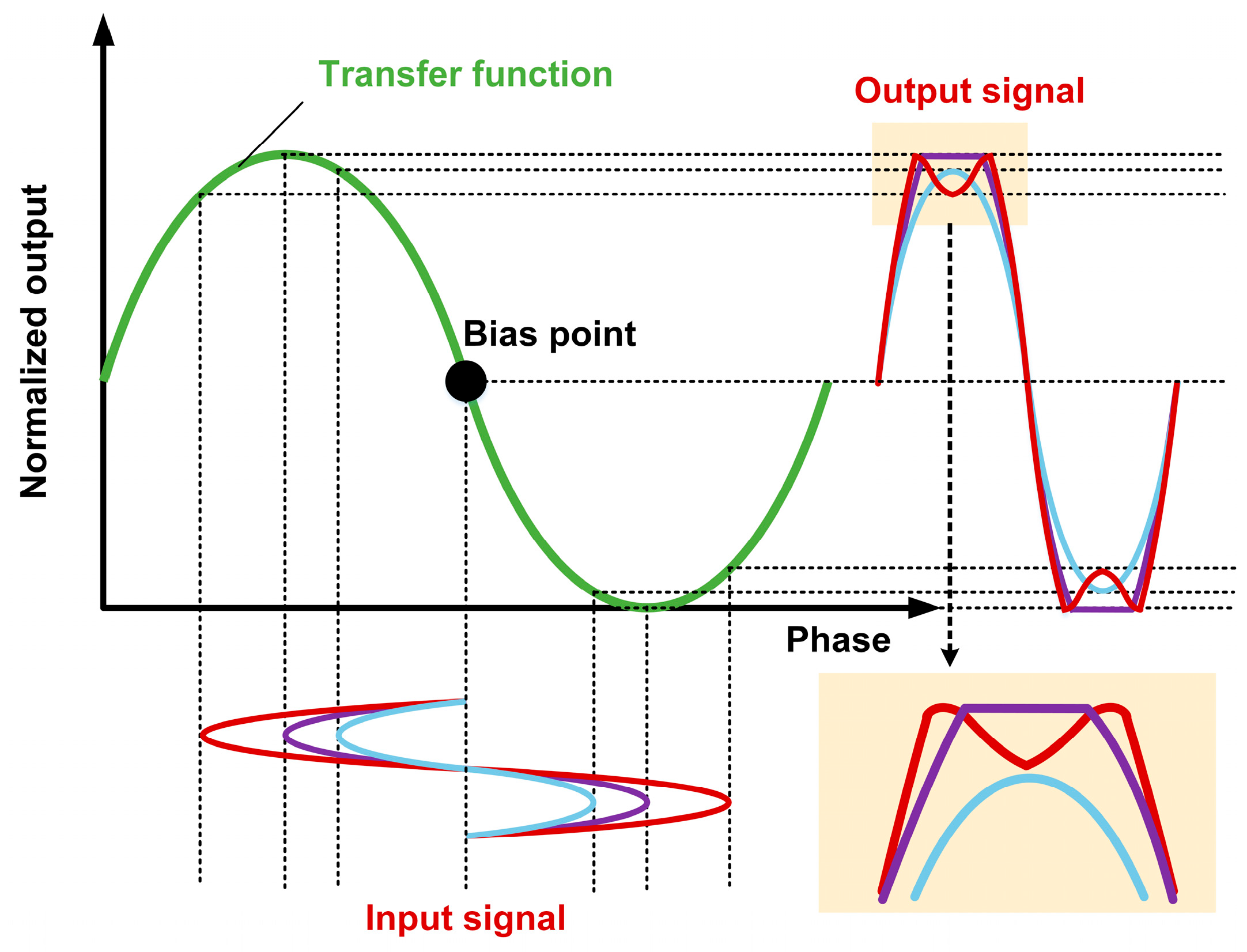
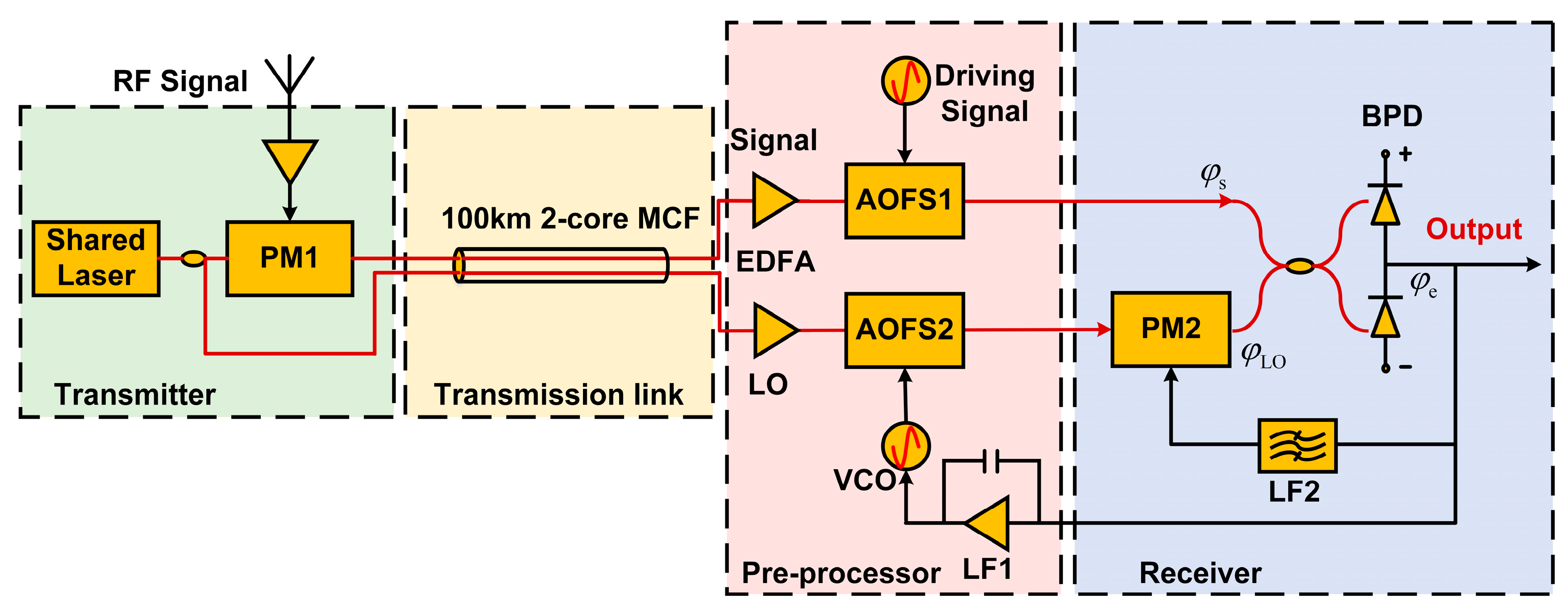
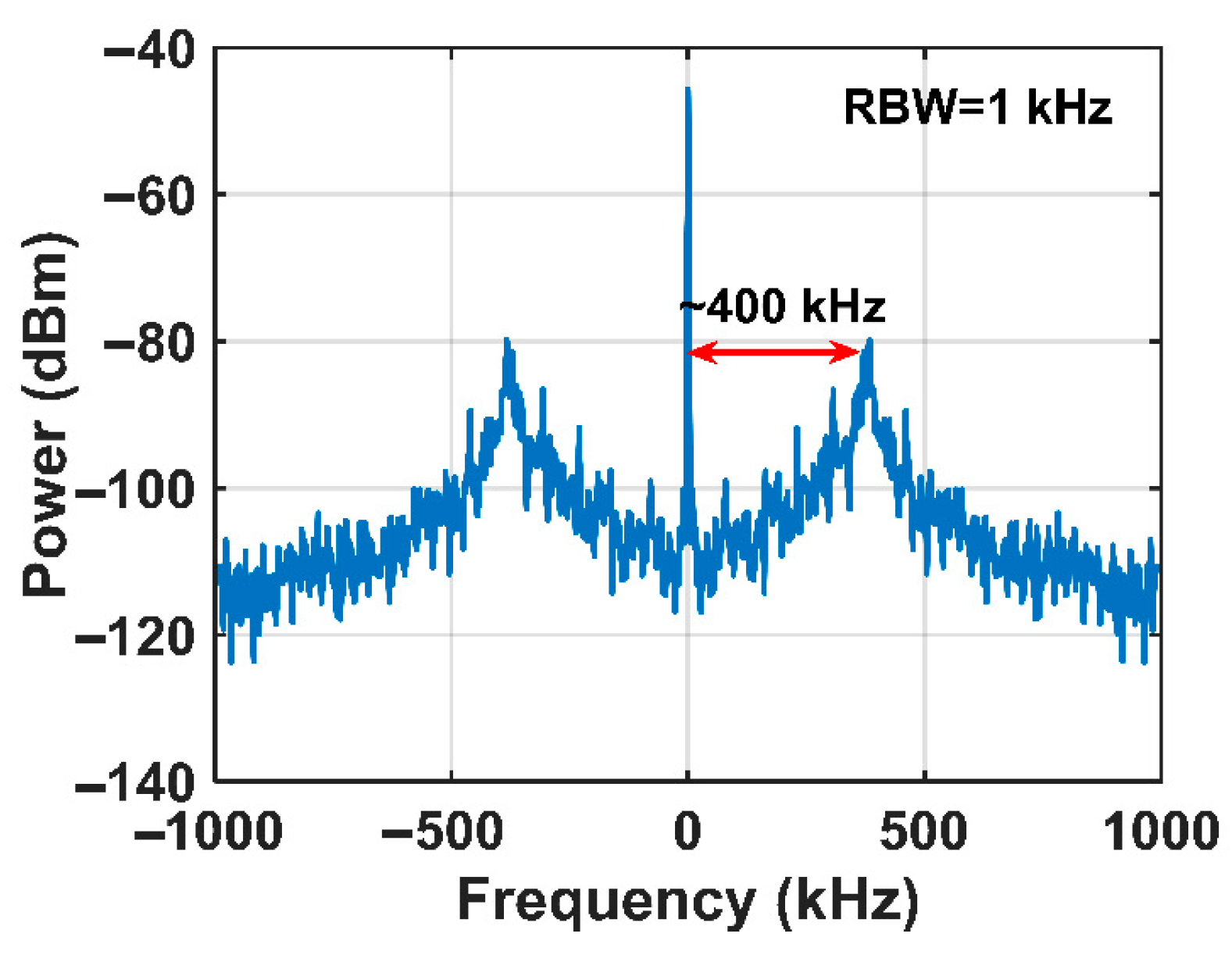
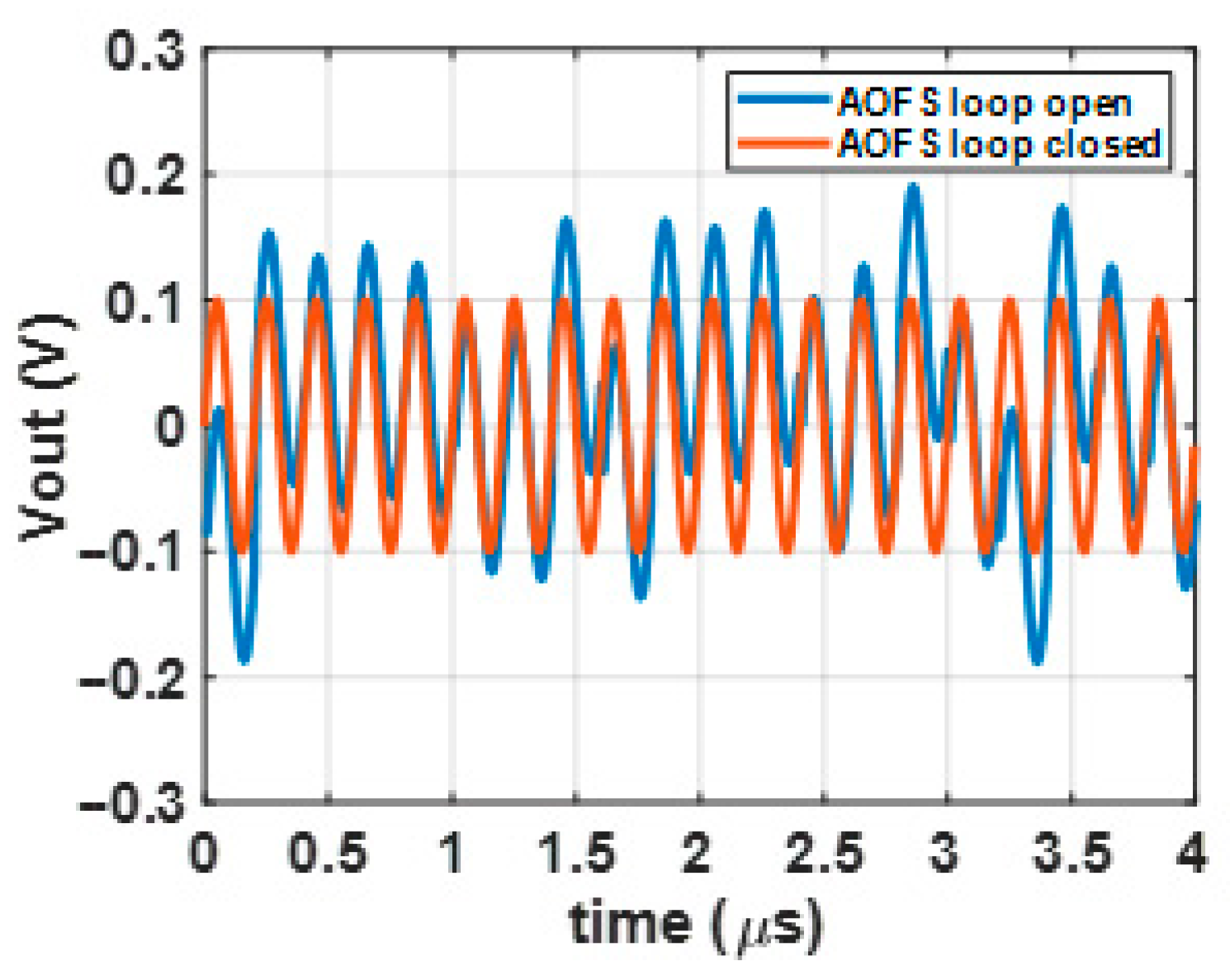


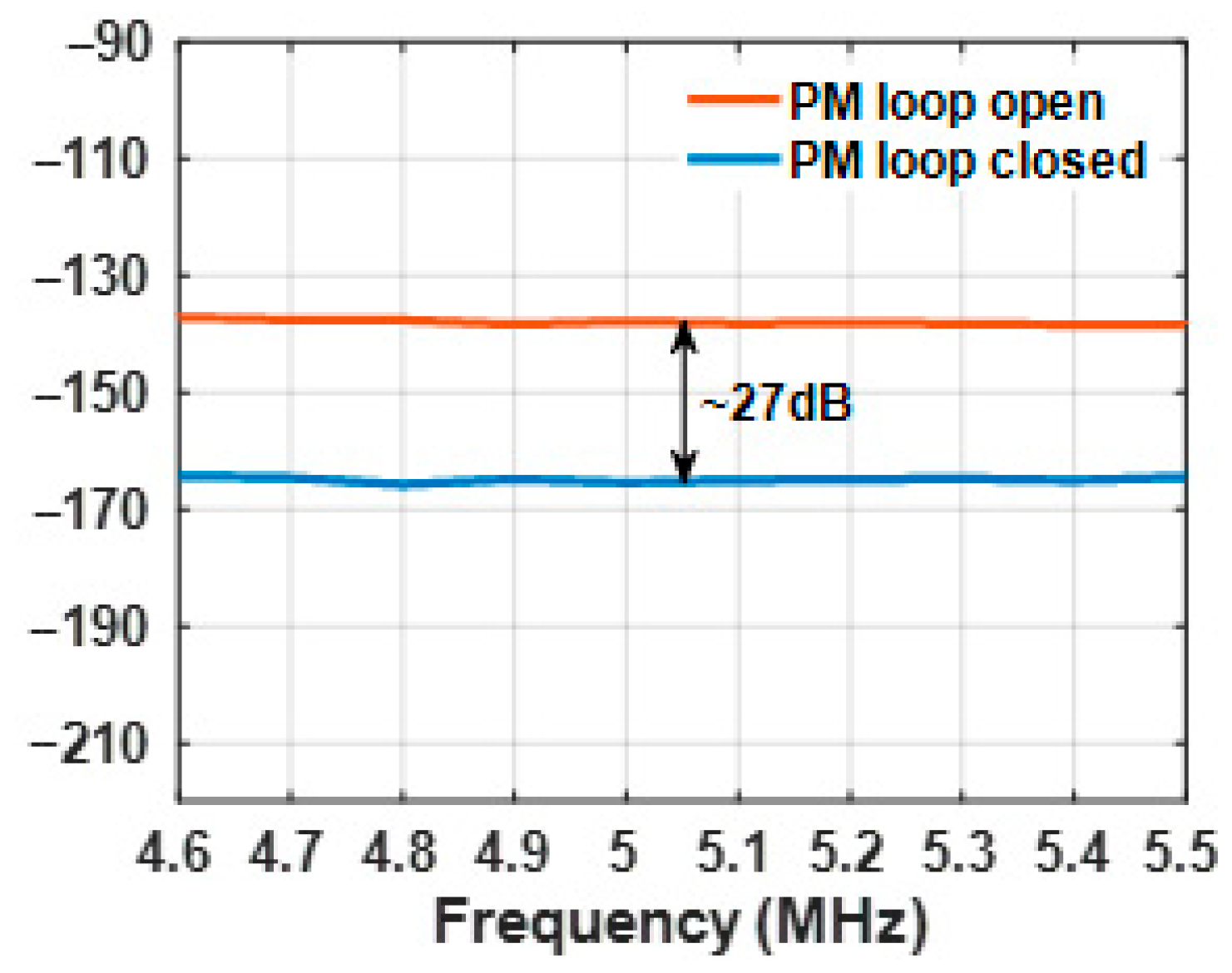
Disclaimer/Publisher’s Note: The statements, opinions and data contained in all publications are solely those of the individual author(s) and contributor(s) and not of MDPI and/or the editor(s). MDPI and/or the editor(s) disclaim responsibility for any injury to people or property resulting from any ideas, methods, instructions or products referred to in the content. |
© 2025 by the authors. Licensee MDPI, Basel, Switzerland. This article is an open access article distributed under the terms and conditions of the Creative Commons Attribution (CC BY) license (https://creativecommons.org/licenses/by/4.0/).
Share and Cite
Bai, Y.; Zhang, Z.; Xie, W.; Li, Y.; Tian, T.; Yuan, D.; Shen, H. High-Fidelity Long-Haul Microwave Photonic Links with Composite OPLLs and Multi-Core Fiber for Secure Command and Control Systems in Contested Environments. Photonics 2025, 12, 893. https://doi.org/10.3390/photonics12090893
Bai Y, Zhang Z, Xie W, Li Y, Tian T, Yuan D, Shen H. High-Fidelity Long-Haul Microwave Photonic Links with Composite OPLLs and Multi-Core Fiber for Secure Command and Control Systems in Contested Environments. Photonics. 2025; 12(9):893. https://doi.org/10.3390/photonics12090893
Chicago/Turabian StyleBai, Yuanshuo, Zhaochen Zhang, Weilin Xie, Yang Li, Teng Tian, Dachuan Yuan, and Haokai Shen. 2025. "High-Fidelity Long-Haul Microwave Photonic Links with Composite OPLLs and Multi-Core Fiber for Secure Command and Control Systems in Contested Environments" Photonics 12, no. 9: 893. https://doi.org/10.3390/photonics12090893
APA StyleBai, Y., Zhang, Z., Xie, W., Li, Y., Tian, T., Yuan, D., & Shen, H. (2025). High-Fidelity Long-Haul Microwave Photonic Links with Composite OPLLs and Multi-Core Fiber for Secure Command and Control Systems in Contested Environments. Photonics, 12(9), 893. https://doi.org/10.3390/photonics12090893



